
From signing bonuses to relocation and continuing education allowances, your employment contract needs to provide more than a competitive salary.
Fam Pract Manag. 2017;24(5):9-11
Author disclosures: The authors disclose that they are employed by a physician search firm; no other relevant financial affiliations disclosed.

The primary feature of most physician employment contracts is, of course, a base salary. A standard contract will typically stipulate a guaranteed amount that the physician will be paid and may also include a production bonus formula. Most production bonuses are based on relative value units (RVUs) or other volume-related metrics, although a growing number may include value-related metrics such as patient satisfaction scores, adherence to treatment protocols, or use of electronic health records (EHRs). Between the base salary and the production bonus outlined in the contract, physicians should be able to determine both the minimum amount they will earn during the contract period and the maximum they could achieve through the bonus.
Beyond the basic financials, physician employment contracts also generally include a range of other benefits, which we will describe in this article. It should be noted that this information is derived mostly from larger employers such as hospitals, health systems, large medical groups, and community health centers working with our search firm. The employment terms offered by smaller groups may vary from what is described.
Signing bonuses
Physician recruiting has become highly competitive because of an emerging physician shortage that is particu larly acute in primary care. Seventy percent of physicians receive 51 or more job solicitations during the course of their training, and 50 percent receive 100 or more. For primary care residents, the numbers are even higher, with 78 percent receiving 51 or more job solicitations and 55 percent receiving 100 or more.1
For the 11th year in a row, family medicine was the most requested type of search for our firm,2 and most family physicians are the focus of continuous recruiting activity.
To differentiate themselves, employers such as hospitals, medical groups, and others often offer physician candidates a signing bonus. Signing bonuses are intended to create a sense of urgency and commitment, and they can prove to be the extra impetus physicians need to put their name on a contract. Signing bonuses also provide physicians with a short-term financial infusion that can make a move more feasible and appealing.
A dozen years ago, fewer than half of our firm's search assignments featured a signing bonus. That number now stands at 76 percent.2 It would be higher, but some service sites that have proliferated rapidly in recent years, including urgent care centers and Federally Qualified Health Centers (FQHCs), usually do not offer signing bonuses. The average signing bonus for all physicians is currently $32,636.2 (See the range offered in “Signing bonuses, all physicians.”)
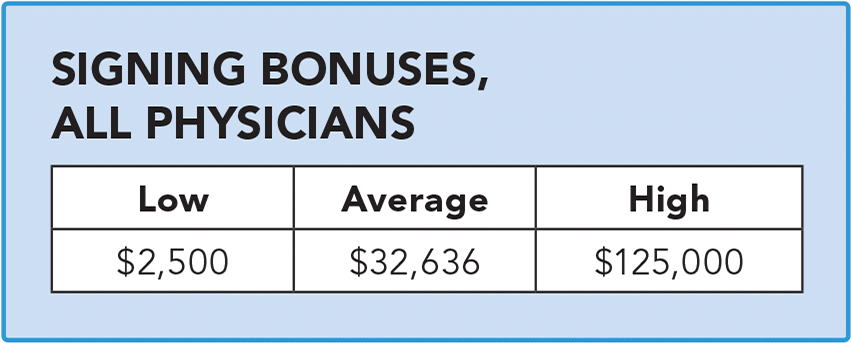
| Low | Average | High |
|---|---|---|
| $2,500 | $32,636 | $125,000 |
Because signing bonuses are often based on salary, high-earning surgical and diagnostic specialists usually receive higher signing bonuses than more moderately earning family physicians and other primary care doctors. For family physicians, the average signing bonus is currently $22,050.2 (See the range offered in “Signing bonuses, family medicine.”)
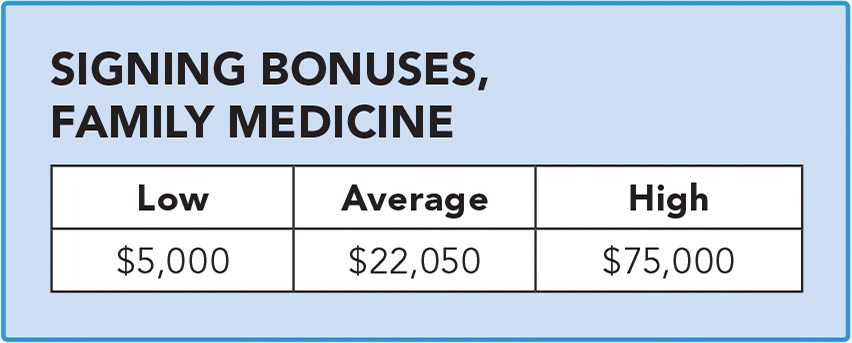
| Low | Average | High |
|---|---|---|
| $5,000 | $22,050 | $75,000 |
Signing bonuses are negotiable within a few thousand dollars of the offered amount, and it is not inappropriate for physicians to ask for some flexibility on this and other benefits. Physicians leaving established practices and relocating may be particularly justified in requesting a more robust signing bonus.
Relocation allowances
Approximately 12 percent of family physicians relocate in the course of a year.3 Most of these physicians are moving to new practices. To make relocation easier and encourage physicians to accept their job offers, employers typically include a relocation allowance in the employment contract. Relocation allowances are featured in 95 percent of physician contracts and average $10,072 for all physicians.2 (See the range offered in “Relocation allowance, all physicians.”)
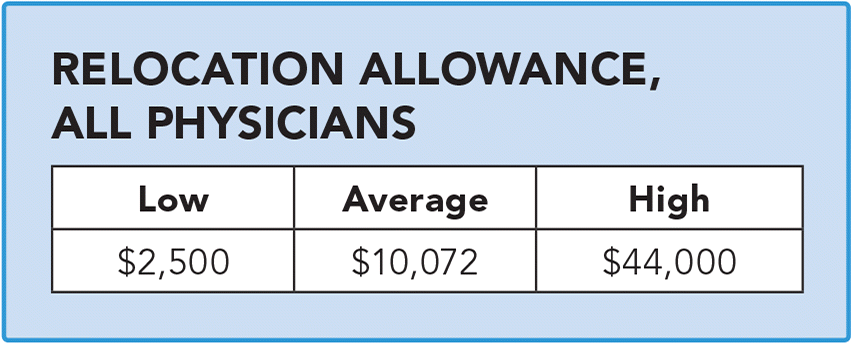
| Low | Average | High |
|---|---|---|
| $2,500 | $10,072 | $44,000 |
Relocation allowances typically do not vary by specialty but may vary in special circumstances. For example, if a physician owns multiple vehicles, must relocate from a long distance, or has other unusual moving needs, he or she may be able to negotiate a higher relocation allowance.
Continuing medical education allowances
Physicians are obligated to keep up their skills and knowledge through CME, and most employers are willing to help defray the cost. CME allowances are offered in 95 percent of physician employment contracts with the average amount being $3,613 per year for all physicians. (See the range offered in “CME allowance, all physicians.”)
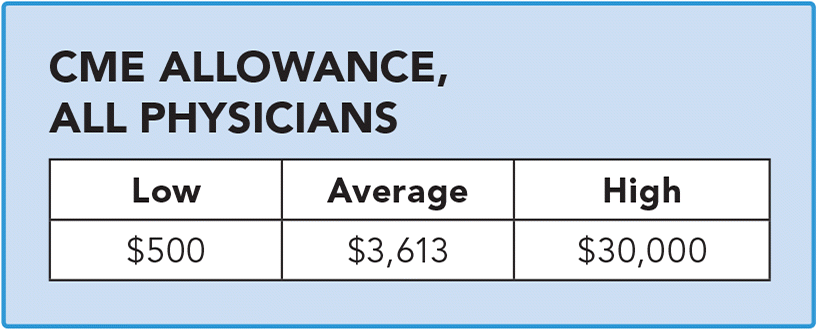
| Low | Average | High |
|---|---|---|
| $500 | $3,613 | $30,000 |
Like relocation allowances, CME allowances generally do not vary by specialty, and the average amount has hovered around $3,000 to $3,600 for more than a decade with little room for negotiation. An exception may be made for those seeking to learn or maintain skills in complex procedures.
In most cases, physicians are contractually allotted five days annually for CME. This may vary occasionally, usually for subspecialists, but because CME can often be earned online rather than through travel, employers are less inclined to increase the days allotted to CME.
Additional benefits
The great majority of physicians today are being hired as employees of some type of health care facility. This is significantly different from the past when a health care facility, such as a hospital, would establish a newly recruited physician in private practice and front the physician's expenses with a loan or income guarantee. About 95 percent of physician contracts today feature a true employment arrangement offering a salary, rather than an independent practice arrangement offering a loan or income guarantee.2 As a result, physicians today typically are offered a range of benefits similar to those offered to other employed professionals. Health insurance, malpractice insurance, disability insurance, and some form of retirement plan, such as a 401(k) or (very rarely) a pension, are standard benefits found in physician employment contracts. (See “Other benefits offered, all physicians.”)
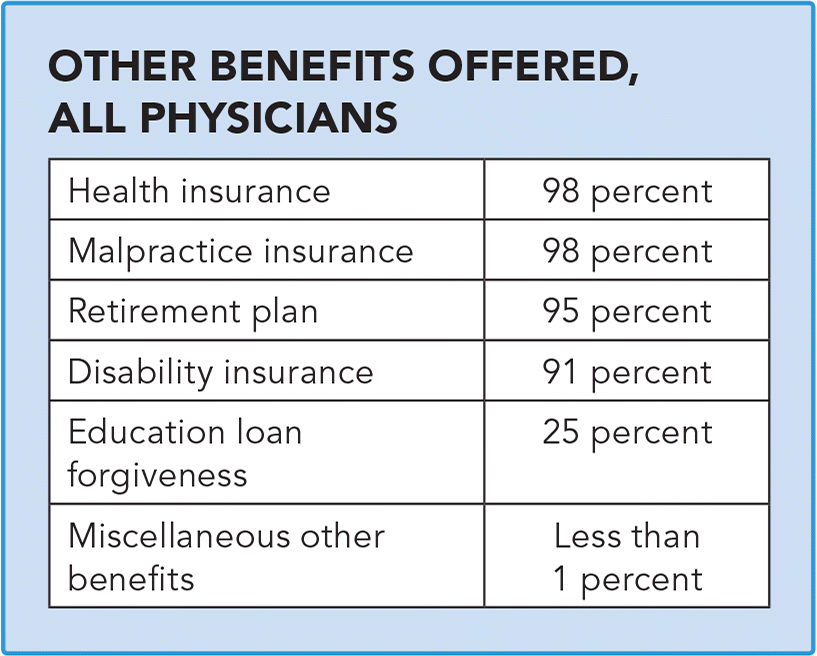
| Health insurance | 98 percent |
| Malpractice insurance | 98 percent |
| Retirement plan | 95 percent |
| Disability insurance | 91 percent |
| Education loan forgiveness | 25 percent |
| Miscellaneous other benefits | Less than 1 percent |
One quarter of physician employment contracts feature educational loan forgiveness, in which the recruiting hospital or other facility agrees to pay the physician's medical school loans in exchange for a commitment to stay in the community for a given period of time. The loan forgiveness term is usually three years, although two-year and one-year terms also are offered. The average amount of loan forgiveness offered to physicians is $80,923, with a low of $10,000 and a high of $260,000.2 The amount is negotiable, but usually only facilities in underserved areas that have experienced extraordinary difficulty in recruiting doctors will offer the higher amounts.
Certain state and federal programs, such as the National Health Service Corps, offer educational loan forgiveness to physicians willing to practice in rural areas – arrangements in which the physician bears no tax burden. When educational loan forgiveness is offered directly to physicians by hospitals rather than government programs, the payments are considered taxable income. In addition, if the physician chooses to leave the employer before the end of the term, the contracts generally require that the physician pay back any loan repayment monies they received, sometimes with interest.
Beyond the salary
Physicians considering employment contracts often focus a great deal on the salary and the bonus structure. These are two critical components of the contract, but you should consider other aspects, including benefits, to ensure the contract is fair and competitive.
